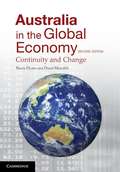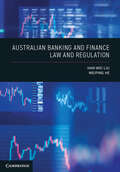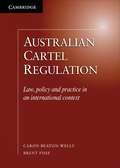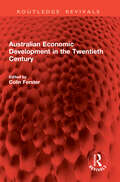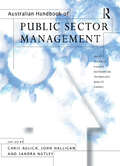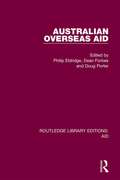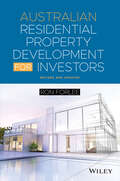- Table View
- List View
Australia in the Global Economy
by Barrie Dyster David MeredithWith the global economy in crisis, there is great need for a deeper understanding of Australia's economic place in the world - both today and throughout history. This new edition of Barrie Dyster and David Meredith's highly successful book is fully updated and includes three new chapters covering until the end of 2011. The book explores the evolution of Australia's position in the global economy from the start of the twentieth century through to the present day, examining the international and local economies of five key historical periods. With a focus on trade, foreign investment and immigration, the book considers periods both of growth and decline. By using historical perspectives to explain the present and give direction to the future, this unique book presents a rich account of Australia's position within a global economic context. It is an essential resource for students and lecturers of Australian economic history.
Australia in the US Empire: Australia In The Us Empire
by Erik PaulThis book argues that Australia is vital to the US imperial project for global hegemony in the struggle among great powers, and why Australia’s deep dependency on the US is incompatible with democracy and the security of the country. The Australian continent is increasingly a contestable geopolitical asset for the US grand strategy and for China’s economic and political expansionism. The election of Donald Trump to the US presidency is symptomatic of the US hegemonic crisis. The US is Australia’s dangerous ally and the US crisis is a call for Australia to regain sovereignty and sever its military alliance with the US. Political realism provides a critical paradigm to analyse the interactions between capitalism, imperialism and militarism as they undermine Australian democracy and shift governmentality towards new forms of authoritarianism.
Australia's Competitiveness: From Lucky Country to Competitive Country
by Michael J. Enright Richard PettyIn this in-depth overview of Australia's economy, Michael Enright and Richard Petty — leading scholars on international competition—look at the data behind the news reports to offer a complete view of Australia's stable and wealthy economy. The book compares Australia with other similarly sized OECD economies as well as other Asia-Pacific economies and looks at fifteen international sources of data on competitiveness. It features a large-scale survey on Australian companies and offers deep insight on the country's future in terms of economics and economic policy. Revealing an honest assessment of Australia's true position in the world, the book looks at how Australian businesses see themselves and offers policy positions for government and firms to make the most of Australia's unique global economic position. Backed by CPA Australia, one of the world's largest accounting bodies Written by two global authorities on economic competitiveness Captures the thinking of more than 6,000 business leaders both within and outside of Australia Explains how Australia has weathered the global recession and looks at Australia's relationship with China For business leaders and policy makers in need of an in-depth look at the current and future state of Australia's economy, this book offers valuable and comprehensive information.
Australia's Home Buying Guide: How to buy a property faster and for less
by Todd SloanA must-read, practical insider's guide for all home buyers.Whether you're buying your first home, your next home or your forever home, the proven process shared throughout this book will be an invaluable guide. Award-winning real estate agent and popular podcaster Todd Sloan speaks with hundreds of people each week and their objectives are always the same: they want to find and purchase the right property quickly and for a good price.Sharing insider tips and tricks that selling agents wouldn't normally disclose, Australia's Home Buying Guide is an insightful, practical and fun guide that takes the stress out of buying a home. It covers common pitfalls and traps buyers should watch out for when they're at the start of their search, such as:How to make sure you get your finances approved correctly. How to get the best deal on your loan and potentially save thousands of dollars.How to find the right area for you and your family (if you have one).What questions to ask the agent to give you a competitive edge.How to read a selling agent's tricks and potentially save stacks of cash.Knowing your rights if you change your mind after you've signed the contract. Todd Sloan has a genuine passion for helping people during what is often a scary and stressful process, and he brings a unique and useful insider's perspective on how to buy property in this must-read guide for home buyers.
Australia-Japan Cable: Structuring the Project Company
by Benjamin C. Esty Carrie FermanIn late September 1999, representatives from Telstri, Japan Telecom, and Teleglobe met to discuss the structure of the Australia-Japan Cable (AJC) project, a $520 million submarine cable system that would run from Australia to Japan. The sponsors, excited by the possibility of large returns, needed to move quickly to capitalize on the projected shortfall in Australia's broadband capacity. As telecommunications carriers, the sponsors needed additional capacity to serve their retail and wholesale customers. As cable system owners, they wanted to earn an appropriate return on their invested capital while mitigating ownership risks. The need to move quickly in the face of significant demand, competition, and technological uncertainty made it particularly risky to invest at this time.
Australia: Benefiting from Economic Reform
by Anoop Singh Tim Callen Ray Brooks Josh Felman Christian ThimannA report from the International Monetary Fund.
Australia: Commodities and Competitiveness
by Laura Alfaro Richard H.K. Vietor Hilary White William RussellFor the past few decades, Australia has dealt with the benefits and costs of repeated mining booms--inflation, a housing bubble, a current account deficit and growing dependence on China. Between 1996 and 2007, however, Australia had most of these issues under control and grew at impressive rates, becoming one of the richest of developed countries. Yet competitiveness in its non-mining sectors declined. Since the financial crisis, additional challenges associated with climate change, minerals taxes, migration and an overvalued currency have complicated the issues facing Julia Gillard and her Labor Party, with a very thin majority.
Australia: Commodities, Competitiveness, Climate and China
by Laura Alfaro Richard H.K. VietorFor the past few decades, Australia has dealt with the benefits and costs of repeated mining booms-inflation, a housing bubble, a current account deficit and growing dependence on China. Between 1996 and 2007, however, Australia had most of these issues under control and grew at impressive rates, becoming one of the richest of developed countries. Yet competitiveness in its non-mining sectors declined. Since the financial crisis, additional challenges associated with climate change, minerals taxes, migration, fiscal deficits and currency fluctuations have complicated the issues facing both Labor and Liberal administrations, with a very thin majority. Meanwhile, Australia's non-mineral competitiveness continues to recede.
Australia: Selected Issues
by International Monetary FundA report from the International Monetary Fund.
Australia: The Riches and Challenges of Commodities
by Laura Alfaro Renee KimAustralia's Prime Minister Kevin Rudd faced a daunting task that he never imagined he would have to face when he was elected two years ago. Australia at that time was poised to enter its 17th year of uninterrupted growth. Commodity exports were booming, largely driven by China's insatiable appetite for raw materials. Then the global financial crisis erupted in 2008, brewing challenges for the world's biggest exporter of coal and iron ore. Prime Minister Rudd pushed for massive stimulus packages to revive domestic consumption and demand. Yet as an economy heavily dependent on trade, tumbling commodity prices brewed difficult times for Australia's trade deficit and its persistent large current account deficit. What was in hold for Australia's deficit, which had been in the red all but four years since 1950? In addition, how should policymakers address the intense concerns regarding China's growing interest in Australia's prized natural resources sector?
Australian Banking and Finance Law and Regulation
by Weiping He Han-Wei LiuAustralian Banking and Finance Law and Regulation provides a comprehensive, up-to-date and accessible introduction to the complexities of contemporary law and regulation of banking and financial sectors in one volume. The book provides a detailed analysis of Australia's financial market regulatory framework and the theoretical underpinnings of government intervention in the field. It delves into the legal changes implemented in response to the Global Financial Crisis and recent local scandals, exploring the complexities and subtleties of the 'banker–customer' relationship. Readers will appreciate the clear and concise treatment of key issues, cases and examples that offer an overview of major developments. The questions and answers at the end of each chapter serve as an effective tool for readers to assess and reinforce their grasp of the fundamental principles discussed.
Australian Cartel Regulation
by Caron Beaton-Wells Brent FisseCartel regulation is a prime element of competition policy and an essential means of minimising the adverse effects of cartel activity on economic welfare. However, effective cartel regulation poses distinct challenges for governments, competition authorities and commentators across the globe. In Australian Cartel Regulation, leading competition law experts Caron Beaton-Wells and Brent Fisse reflect on developments in anti-cartel law in Australia over the last 30 years. They provide a comprehensive account of the current law on cartels as well as discussing key issues that may arise in the future. This definitive volume not only identifies the practical and theoretical issues, but also recommends workable solutions, and does so with the benefit of comparative analysis of the anti-cartel laws of major overseas jurisdictions. Many of the issues identified and discussed in Australian Cartel Regulation are common to any scheme designed to regulate cartel conduct.
Australian Climate Policy and Diplomacy: Government-Industry Discourses (Routledge Focus on Environment and Sustainability)
by Ben L. ParrAustralian Climate Policy and Diplomacy provides a well overdue critique of existing, and high-profile, publications that convey the ‘greenhouse mafia’ hypothesis, which posits that Australia’s weak policy response to climate change is the result of a menacing domestic fossil fuel lobby. Ben L. Parr argues that the shared government–industry discourse about protecting Australia’s industrial competitiveness has had a more decisive influence in shaping and legitimising Australian climate policy than the direct lobbying tactics of the fossil fuel industry. Parr also reveals how the divergent foreign policy discourses and traditions of Australia’s two major political parties – as internationalist versus alliance-focused – have enabled and constrained their climate diplomacy and domestic policies over time. To demonstrate his argument, he presents a discourse analysis woven into a chronological policy narrative, comprising more than 1000 primary texts (media releases, interviews, and speeches) generated by prime ministers and key fossil fuel lobbyists. Overall, this volume illustrates how domestic forces have and are influencing Australia’s climate policy. In doing so, it also provides a framework that can be adapted to examine climate mitigation policies in other countries, notably Canada and the US. This book will be of interest to students and scholars of climate change, environmental policy and governance, and Australian climate change policy and politics more specifically, as well as policymakers and practitioners working in these fields.
Australian Early Childhood Teaching Programs: Perspectives and Comparisons to Finland, Norway and Sweden (SpringerBriefs in Education)
by Wendy BoydThis book examines the approaches, content and design, and practices of current early childhood teacher preparation programs in universities across Australia, and compares them with those in Finland, Norway and Sweden. It is well established that investment in good quality early childhood education yields the best outcomes for children, and that there is significant correlation between quality early childhood learning environments and qualified teachers. As such, this book offers key insights into academic approaches to the design, implementation and assessment of early childhood teacher programs, and how these programs are shaped in response to requirements and constraints, both within the university context and beyond. This book provides a focus to inform future practice for decision-makers of early childhood teacher policy; researchers interested in improving the quality and status of early childhood education; and assessors of early childhood teacher programs.
Australian Economic Development in the Twentieth Century (Routledge Revivals)
by Colin ForsterFirst published in 1970, Australian Economic Development in the Twentieth Century analyses aspects of Australian economic development in the twentieth century and places them in historical and international perspective. In Australia, the nineteenth century has been studied much more intensively than the twentieth, and in this latter period the long-run examination of almost any economic topic must break new ground. The main economic histories of the period were written either before the Second World War or come close to general history. Earlier works have naturally dated, and little has been done to integrate the periods before and after the war.The book takes a step towards filling a wide gap in our understanding of Australian development and covers the period from the depression of the 1890s right up to the 1960s. It is the product of a team of Australia’s economic historians working together, but each sovereign on his own special subject. This volume will appeal not only to economic historians but to a wider public interested in Australia’s history.
Australian Export
by Bernard Bishop Justin MalbonAustralian Export: A Guide to Law and Practice provides students and business people interested in international trade with a clear and concise guide to the main procedures and regulatory environment for international business transactions. The book contains details on the steps involved in a direct sale of goods including: international sales law, trade terms, payment mechanisms, transport, insurance, customs arrangements (including importing) and dispute resolution. It also canvasses the legal and procedural considerations for exporting via an agent or distributor, via licensing and franchising arrangements or through the establishment of an overseas presence in the target market. This comprehensive guide to export and import procedures and regulations also points to the various sources where more in-depth information can be found if required. This book is an essential starting point for understanding the requirements and pitfalls of international business transactions.
Australian Handbook of Public Sector Management
by John Halligan Sandra Nutley Chris Aulich'This is an excellent 'do-it-yourself' introductory study to public sector management, covering a wide range of issues, including recent public service reforms. I recommend it to anyone interested in the practice and study of public sector management.' - Tony Ayers, National President, Institute of Public Administration AustraliaThe traditional view of public sector management is under challenge. The shifting boundaries of the public-private sector are transforming the nature of the public sector in the 21st century and placing increasing demands on managers. This user-friendly handbook examines the changes that have taken place over the last twenty years and addresses the practical issues faced by public servants today. It makes abundant use of exhibits, case studies and real world examples to illustrate key concepts in public sector management. By including many 'points for reference', the authors challenge readers to apply both theory and practice to those public services situations with which they are familiar.Australian Handbook of Public Sector Management is a unique blend of academic and practical approaches to current management practices in the public sector. It has been designed to assist students and those new to the public sector to develop the knowledge and skills they require to provide high quality public services.
Australian Intellectual Property Law
by Leanne Wiseman Mark J. Davison Ann L. Monotti Mark J. Davison Ann L. MonottiIntellectual property law in Australia is a constantly changing field. Developments in technology, such as in the life sciences and in the digitisation of the creation, analysis, distribution and use of information, along with economic globalisation, are having an increasingly significant impact on this field of law. The third edition of Australian Intellectual Property Law has been updated to include the most important recent developments in intellectual property law, including: - the 'Raising the Bar' amendments to the Patents Act and case law concerning the meaning of 'manner of manufacture' - proposed reforms to the Copyright Act - the High Court's consideration of trademarks in various contexts - recent statutory changes and court judgments. Through its comprehensive discussion of the black-letter aspects of the law, and primary emphasis on legal principles and complexities, Australian Intellectual Property Law continues to offer a detailed and scholarly insight into Australian intellectual property law for students and professionals.
Australian Overseas Aid
by Doug Porter Dean Forbes Philip EldridgeOriginally published in 1986, this book evaluated the review of the Australian Overseas Aid Program (the 1984 Jackson Report) and discusses the significance of Australia’s contribution to overseas aid for the future. The book focusses on the overall context of the Jackson report; discusses the geographical distribution of aid proposed by the report and examines aid administration in its more specific bureaucratic context and with broader questions of community participation in developmental processes.
Australian Paper Manufacturers (A)
by Joshua D. Margolis David M. UptonDescribes a company which has broken an unwritten cordial agreement amongst the three Australian paper manufacturers to split the domestic market three ways by market segment. The company invades another's "territory" with advanced technology, quality, and, importantly, by using the other company's poor environmental record to protect itself against retaliation. The defender finds itself unable to respond by adding capacity as public pressure denies it the ability to add capacity and upgrade the technology. Having won a large share of the market, and having successfully introduced a new recycled paper product, the invader is now considering the financial, strategic, and ethical issues of further expansion.
Australian Political Economy of Violence and Non-Violence
by Erik PaulThis book is the first to establish the nature and causes of violence as key features in the political economy of Australia as an advanced capitalist society. Australia's neoliberal corporate security state in seen to represent the emergence of a post-democratic order, whereby minds and bodies are disciplined to the dominant ideology of market relations. Locating questions of the democracy and of the country's economy at the heart of Australia's political struggle, the author elaborates how violence in Australia is built into a hegemonic order, characterized by the concentration of private power and wealth. Identifying the commodification of people and nature, the construction and manipulation of antagonisms and enemies, and the politics of fear as features of a new authoritarianism and one-party-political state, Erik Paul explores alternatives to the existing neoliberal hegemonic order. Positing that democratization requires a clearly defined counter-culture, based on the political economy of social, economic and political equality, the book draws out the potential in non-violent progressive social movements for a new political economy.
Australian Residential Property Development for Investors
by Ron ForleeThe all-in-one reference for the new residential real estateinvestor Australian Residential Property Development for Investorsis the practical, step-by-step guide for beginners and experiencedinvestors in the real estate and construction industries. From siteselection to sale, this book walks you through each phase of theproperty development process to show you how careful planning canconsiderably enhance returns on your investment. This practical andeffective guide features the latest information on developmenteconomics, the impact of electronic media, new cost-effectivebuilding methods, and a collection of case studies that illustratethese ideas in action. With a focus on practical outcomes, you'lllearn how to approach the property from an investor's perspectiveto minimize risk and maximize returns.Australians have long had a love affair with residentialproperty. We have one of the highest rates of home ownership in theworld, and investing in residential real estate is a popular routeto financial security. This book shows you how to make propertydevelopment feasible within your time and budget constraints,netting you more profit and less headache.Select the site with the most profit potential, and finddependable financingWork more effectively with contractors, councils, consultants,and solicitorsApply standard monitoring and risk management techniques toyour investmentCost and market the improved property appropriately to targetthe right buyersNewcomers are understandably overwhelmed by zoning, financing,construction, marketing, and everything else that goes intoproperty development, frequently resulting in mistakes and missedprofit. For the fledgling developer hoping to make the most of anew investment, Australian Residential Property Development forInvestors provides all-in-one reference, with proven systems,techniques, and tools.
Australian Residential Property Development for Investors
by Ron ForleeThe all-in-one reference for the new residential real estate investor—revised and updated for 2022 and beyond Australian Residential Property Development for Investors is the practical, step-by-step guide for beginners and experienced investors in the real estate and construction industries. From site selection to sale, this book walks you through each phase of the property development process to show you how careful planning can considerably enhance returns on your investment. This practical and effective guide features the latest information on development economics, the impact of electronic media, new cost-effective building methods, and a collection of case studies that illustrate these ideas in action. With a focus on practical outcomes, you'll learn how to approach the property from an investor's perspective to minimize risk and maximize returns. Australians have long had a love affair with residential property. We have one of the highest rates of home ownership in the world, and investing in residential real estate is a popular route to financial security. This book shows you how to make property development feasible within your time and budget constraints, netting you more profit and less headache. Select the site with the most profit potential, and find dependable financing Work more effectively with contractors, councils, consultants, and solicitors Apply standard monitoring and risk management techniques to your investment Cost and market the improved property appropriately to target the right buyers Newcomers are understandably overwhelmed by zoning, financing, construction, marketing, and everything else that goes into property development, frequently resulting in mistakes and missed profit. For the fledgling developer hoping to make the most of a new investment, Australian Residential Property Development for Investors provides all-in-one reference, with proven systems, techniques, and tools.
Australian Wine Cluster, Supplementary Information
by Michael E. Porter Orjan SolvellSupplements The California Wine Cluster.
Australian Women in Advertising in the Twentieth Century
by Jackie DickensonWhen did Australian women first enter the advertising industry? The stereotypical advertising executive might be a pony-tailed, Ferrari-driving, young-ish man, but women have worked in Australian advertising agencies from the first years of the modern industry, and today they comprise half of the industry's workforce. Australian Women in Advertising in the Twentieth Century rescues these women from their obscurity. By employing a broader definition of advertising than usual, this study reveals the important role women have played in the development of the Australian advertising industry, sheds light on women's struggle to reach the higher echelons of the industry, and considers why the popular image of the advertising executive is at such variance from the reality. The experiences of these remarkable women across a century of Australian advertising provide valuable information on the role of gender in the development of this ubiquitous industry, as well as the encroachment of consumer culture.
